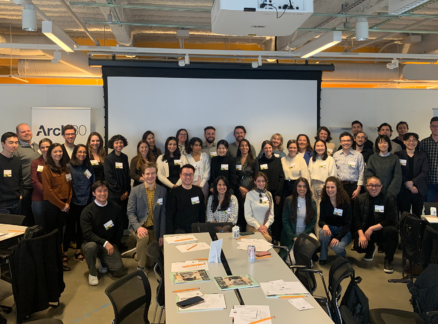April 1, 2007
Uncomfortable but Comforting
Despite its many flaws, the book remains one of our most enduring and endearing objects.
Bound books are among the most inconvenient of all technological devices in common use today, but their basic form has remained essentially unchanged for almost two millennia. Despite advances in design and production, books are often difficult objects to hold and use. It is not only the sheer girth of some volumes that makes them unwieldy; most hardback bindings have sharp corners that press into palms, thighs, or chests. Large-format art books, printed on high-quality paper, are notoriously heavy. The glossy paper can reflect light to a blinding degree, making the images and text a challenge to see without constantly reorienting the volume. These difficulties can be avoided by sitting at a proper desk or table when reading, but who wants opening a book to feel like work?
Still, the book is probably here to stay. Its resilience underscores what I call the power of maker tradition and user expectation. Proponents of electronic books argue that bound paper as we know it will eventually be replaced by newer technology, but that’s not likely to happen in the foreseeable future. The fact that some early e-books were designed to mimic the traditional reading experience by being about the same size as conventional titles and containing “pages” that “turn” emphasizes a kind of unwritten law of maker tradition: when replacing one technology with a newer one, the latter must resemble the former as much as possible. This principle was recognized by early industrial designers such as Raymond Loewy and Henry Dreyfuss. A streamlined toaster succeeds only if it conveys the idea that it is still a toaster. Consumers won’t readily accept something that is so radically new that the functions it is intended to replace are unrecognizable.
I saw my first e-book about ten years ago. Ironically, it was shown to me by a library clerk who was surrounded by shelves of traditional books. She was enthusiastic about the prototype e-book that a manufacturer had loaned her for a month. She excitedly told me how many classics she could load into it, extolling the virtues of reducing the pile of books she would have to carry to a desert island but neglecting to address how she might recharge her newfangled device once there. Perhaps she saw, in the plastic package of electronics, relief from the endless drudgery of finding, checking out, checking in, and reshelving the library’s vast array of bound volumes.
Early e-books did fascinate and charm some readers. Initially the available titles were mostly out-of-copyright works, and avid e-readers soon exhausted the offerings of interest. More options were available for a price, but this didn’t appeal to readers accustomed to the free services of the local public library. The Web has greatly expanded the possibilities, of course, with an enormous electronic library now available to anyone with an Internet connection. You don’t even need a dedicated e-book to read its holding.
In the meantime, the laptop computer has replaced the traditional book in many backpacks, briefcases, and carry-on bags. For some, reading has ceased to mean holding a book. Rather, at least in Microsoft Word, it involves viewing text files. And we can do this in various ways, including a “reading layout,” in which two “facing pages” appear on the computer screen simultaneously. We can go from “print layout” to “reading layout”—a process of turning a manuscript into a bound book that once took months at best—with the click of the mouse.
However, like a lot of things designed in a newer medium to mimic an older one, the reading layout can be maddeningly disorienting. What distracts me most about Word’s setup is that it carries odd page numbers on left-hand pages. This is unnerving because left-hand pages of traditional books are always even-numbered. It’s such a bedrock of professional publishing that it once helped solve a mystery: an otherwise clever thief told the crime investigator that he had merely found what he was accused of stealing slipped between pages 93 and 94 of a book. The detective knew immediately that he had caught the perpetrator, for such pagination was then impossible. That it now can (and does) occur in desktop-published books and in the virtual world of digital books makes me wonder if some of the designers behind our mysterious new technologies are careless about or just oblivious to real-world details.
The properly paginated and bound book won’t be shredded into digital bytes and bits any time soon. Even the most plugged-in among us still enjoy a good book in hard- or softbound form. Airport lounges may be hot spots for cell phones, personal data assistants, and laptop computers, but once we’re aloft, we invariably turn to a traditional book—often a murder mystery or historical novel. There is something reassuring about beginning a long flight with a thick book that we know will provide hours of recreation without the threat of batteries wearing out at a crucial turn in the plot.
To many readers, a book in the hand is worth scores of titles in the e-book. For all their flaws, the books we grew up with have become objects as endearing and enduring as teddy bears and favorite chairs. Real books have a visual texture, a feel, a sound, a smell, and, yes, even a taste that is associated with reading. The smell of paper and glue, especially in a new book, is missing from the e-book. The dust from a tome stored in an attic or basement, or left on a library shelf too long, when disturbed by the gentlest wave of a page gives our noses and mouths the unmistakable sense that a real book is in our grasp. Taking a volume down from the shelf, turning it over in our hands, opening it with our fingers, flipping or thumbing the pages, closing it or slamming it shut, setting or throwing it down—all these simple actions have an emotional value that no e-book yet matches in variety or complexity. (Will sound effects eventually become standard e-book features, reproducing the turning of pages or the familiar sounds of a book being picked up, read, closed, or tossed aside?)
Sony recently released a new version of an e-book system called the “Reader,” but I have yet to encounter a glowing review of the device. An advertisement describes it to be “as easy to carry as a slim paperback, and thanks to electronic paper, easy to read.” A picture shows it opening like a real book, but with text appearing on just the right-hand side. To me this is not a book but a manuscript typed on only one half. And who needs another portable thing to plug into its own dedicated charging device that must join others in bulking up our luggage? So many of us spend so much time in front of flat backlit screens that we’re not looking for opportunities to log more time with them. Rather, we welcome the uncomfortable book with open hands, anticipating a bit of recreational—and escapist—reading as warmly as we might a weekend in the country.





